
John Marcellus Huston was an American film director, screenwriter and actor. He wrote the screenplays for most of the 37 feature films he directed, many of which are today considered classics. Many of his films involved themes such as religion, meaning, truth, freedom, psychology, colonialism, and war. He received numerous accolades including two Academy Awards and three Golden Globe Awards. He also received a star on the Hollywood Walk of Fame in 1960 and the BAFTA Fellowship in 1980.
Desmond Bagley was an English journalist and novelist known mainly for a series of bestselling thrillers. He and fellow British writers such as Hammond Innes and Alistair MacLean set conventions for the genre: a tough, resourceful, but essentially ordinary hero pitted against villains determined to sow destruction and chaos for their own ends.
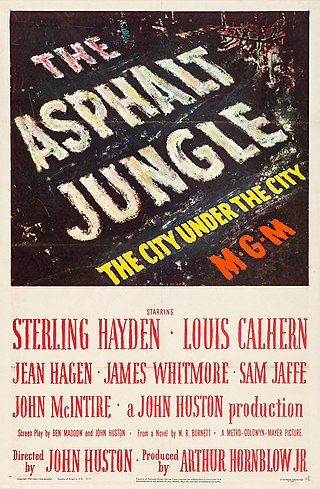
The Asphalt Jungle is a 1950 American film noir heist film directed by John Huston. Based on the 1949 novel of the same name by W. R. Burnett, it tells the story of a jewel robbery in a Midwestern city. The film stars Sterling Hayden and Louis Calhern, and features Jean Hagen, James Whitmore, Sam Jaffe, and John McIntire. Marilyn Monroe also appears in one of her earliest roles, as does Teresa Celli.

Elisha Vanslyck Cook Jr. was an American character actor famed for his work in films noir. According to Bill Georgaris of They Shoot Pictures, Don't They, Cook appeared in a total of 21 films noir, more than any other actor or actress. He played cheerful, brainy collegiates until he was cast against type as the bug-eyed baby-faced psychopathic killer Wilmer Cook in the 1941 version of The Maltese Falcon. He went on to play deceptively mild-mannered villains. Cook's acting career spanned more than 60 years, with roles in productions including The Big Sleep, Shane, The Killing, House on Haunted Hill, and Rosemary's Baby.

They Made Me a Fugitive is a 1947 British film noir set in postwar England.
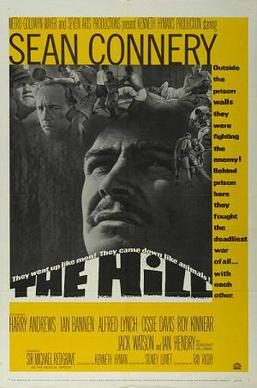
The Hill is a 1965 British prison drama war film directed by Sidney Lumet, set in an army prison in North Africa during the Second World War. It stars Sean Connery, Harry Andrews, Ian Bannen, Ossie Davis, Ian Hendry, Alfred Lynch, Roy Kinnear and Michael Redgrave.
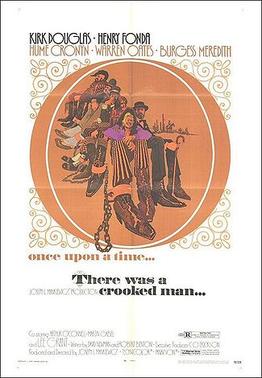
There Was a Crooked Man... is a 1970 American Western film directed by Joseph L. Mankiewicz and starring Kirk Douglas and Henry Fonda. It was the only western made by Mankiewicz. It was written by David Newman and Robert Benton, their first script after Bonnie and Clyde.
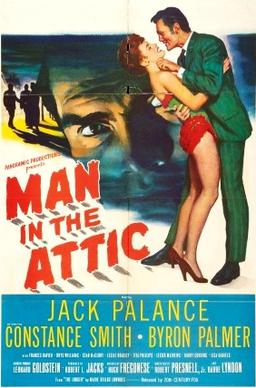
Man in the Attic is a 1953 mystery film directed by Hugo Fregonese. It was released in the United States on December 23 by Twentieth Century Fox. The movie is based on the 1913 novel The Lodger by Marie Belloc Lowndes, which fictionalizes the Jack the Ripper killings, and was previously filmed by Alfred Hitchcock in 1927, by Maurice Elvey in 1932, by John Brahm in 1944, and subsequently by David Ondaatje in 2009.
Shake Hands with the Devil is a 1959 film produced and directed by Michael Anderson and starring James Cagney, Don Murray, Dana Wynter, Glynis Johns and Michael Redgrave. The picture was filmed in Dublin, and at Ardmore Studios in Bray, Ireland. The picture was based on the 1933 novel of the same title by Rearden Conner, the son of a Royal Irish Constabulary policeman.

Dominique Marie-Françoise Renée Varaigne, professionally known as Dominique Sanda, is a French actress.
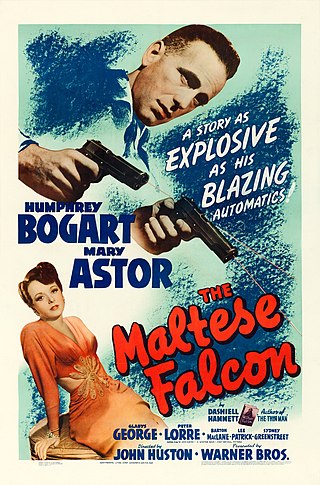
The Maltese Falcon is a 1941 American film noir written and directed by John Huston in his directorial debut, based on the 1930 novel of the same name by Dashiell Hammett and indebted to the 1931 movie of the same name. It stars Humphrey Bogart as private investigator Sam Spade and Mary Astor as his femme fatale client. Gladys George, Peter Lorre and Sydney Greenstreet co-star, with the last appearing in his film debut. A San Francisco private detective deals with three unscrupulous adventurers, all seeking a jewel-encrusted falcon statuette.

Walter Hill is an American film director, screenwriter, and producer known for his action films and revival of the Western genre. He has directed such films as The Driver, The Warriors, Southern Comfort, 48 Hrs. and its sequel Another 48 Hrs., Streets of Fire and Red Heat, and wrote the screenplay for the crime drama The Getaway. He has also directed several episodes of television series such as Tales from the Crypt and Deadwood and produced the Alien films.

The Life and Times of Judge Roy Bean is a 1972 American Western comedy film written by John Milius, directed by John Huston, and starring Paul Newman. It was loosely based on the life and times of Judge Roy Bean.

Harper is a 1966 American mystery film based on Ross Macdonald's 1949 novel The Moving Target and adapted for the screen by novelist William Goldman, who admired MacDonald's writings. The film stars Paul Newman as Lew Harper, and was directed by Jack Smight, with a cast that includes Robert Wagner, Julie Harris, Janet Leigh, Shelley Winters, Lauren Bacall, and Arthur Hill.
John Foreman was an American film producer.

Across the Pacific is a 1942 American spy film set on the eve of the entry of the United States into World War II. It was directed first by John Huston, then by Vincent Sherman after Huston joined the United States Army Signal Corps. It stars Humphrey Bogart, Mary Astor, and Sydney Greenstreet. Despite the title, the action never progresses across the Pacific, concluding in Panama. The original script portrayed an attempt to avert a Japanese plan to invade Pearl Harbor. When the real-life attack on Pearl Harbor occurred, production was shut down for three months, resuming on March 2, 1942, with a revised script changing the target to Panama.

I See a Dark Stranger – released as The Adventuress in the United States – is a 1946 British World War II spy film with touches of light comedy, starring Deborah Kerr and featuring Trevor Howard. It was written and produced by the team of Frank Launder and Sidney Gilliat, with Launder directing.

The Last Run is a 1971 American action film shot in Portugal, Málaga and elsewhere in Spain directed by Richard Fleischer, starring George C. Scott, Tony Musante, Trish Van Devere, and Colleen Dewhurst.

The Freedom Trap is a novel written by English author Desmond Bagley, and was first published in 1971 with a cover by Norman Weaver. It was loosely based on the escape of George Blake from prison five years before. In 1973 it was made into a film entitled The Mackintosh Man, starring Paul Newman.

Dead Man's Evidence is a 1962 British black-and-white crime thriller "B" film directed by Francis Searle, starring Conrad Phillips and Jane Griffiths. A British spy is sent to Ireland to investigate the death of a former colleague who defected.

















